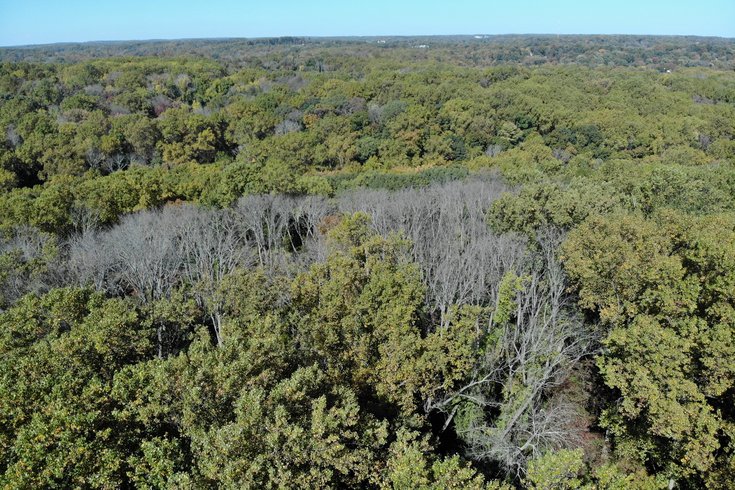
September 28, 2023
 Provided image/Tyler Arboretum
Provided image/Tyler Arboretum
Invasive beetles have killed hundreds of ash trees at Tyler Arboretum, which is now raising funds to remove them from trails. Some of the damaged trees are pictured from above.
Tyler Arboretum has a bug problem, and it's wreaking havoc on the public garden's ash trees.
The Media nonprofit said the emerald ash borer, an invasive beetle known for its distinctive green coloring, has killed nearly 900 of the ash trees on its Delaware County grounds. Those trees are now liable to splinter and fall at any moment, which is why the arboretum closed 17 miles of public trails this summer. They will remain closed while ecologists work to remove the trees.
But the process won't be quick, or cheap. The arboretum said it needs $300,000 to fund the first phase of the project, which targets 584 trees along 9.5 miles of trails. Its long-term fundraising goal, however, is $1 million to $2 million.
Staffers said it's currently unclear how long the trails will remain closed, but that the project would take years.
"At this time, the work to take down the dead and hazardous trees is just beginning," Rachel Keane, digital media and marketing manager for Tyler Arboretum, said in an email. "We are keeping our timeline open due to the many variables this project depends on, including weather and accessibility to the trees."
The pest problems began in 2021, when the arboretum noticed serious damage to its ash trees and closed parts of its trails. But the issue worsened this spring, leading to the closure of all 17 miles of trails outside the arboretum's deer-exclusion fence in late June.
The beetle causing this "ash tree crisis" is native to Asia and was not recorded in the U.S. until 2002, when it was first spotted in southeast Michigan. It has since spread to 36 states, including Pennsylvania and New Jersey. The emerald ash borer damages ash trees by laying eggs in between the cracks of their bark; when the eggs hatch, the larvae then burrow into the trees and remain there until adulthood.
The U.S. Department of Agriculture estimates that the emerald ash borer has killed tens of millions of ash trees since it first appeared in the country.
Once the initial 584 dead trees at Tyler Arboretum are removed, the nonprofit plans to reopen about half of the closed trails. Ecologists then will move on to the roughly 300 remaining trees on more difficult terrains. After every tree is cleared, the arboretum plans to focus on regeneration and restoration, and will invite volunteers to help plant new native species.
"After the trails are safe we can turn to minimizing the ecological impact on our woods," Mike Karkowski, director of horticulture for the arboretum, said in a statement. "We'll have to
find the right balance of leaving organic material on the forest floor for enhancing the soil. We're looking
to keep as many trees as possible as wildlife snags to encourage additional decay that benefits wildlife
like insects, squirrels and woodpeckers."
Unfortunately, once the ash trees are gone from Tyler Arboretum, they're not likely to come back. Current state and national recommendations for warding off emerald ash borers include insecticides and the targeted use of stingless wasps known to attack the beetle's larvae and eggs. But according to Keane, the arboretum does not have the resources to treat the remaining ash trees in time to save them, and expects them to die. Any that do survive will be studied in the hopes of propagating them.
Follow Kristin & PhillyVoice on Twitter: @kristin_hunt
| @thePhillyVoice
Like us on Facebook: PhillyVoice
Have a news tip? Let us know.